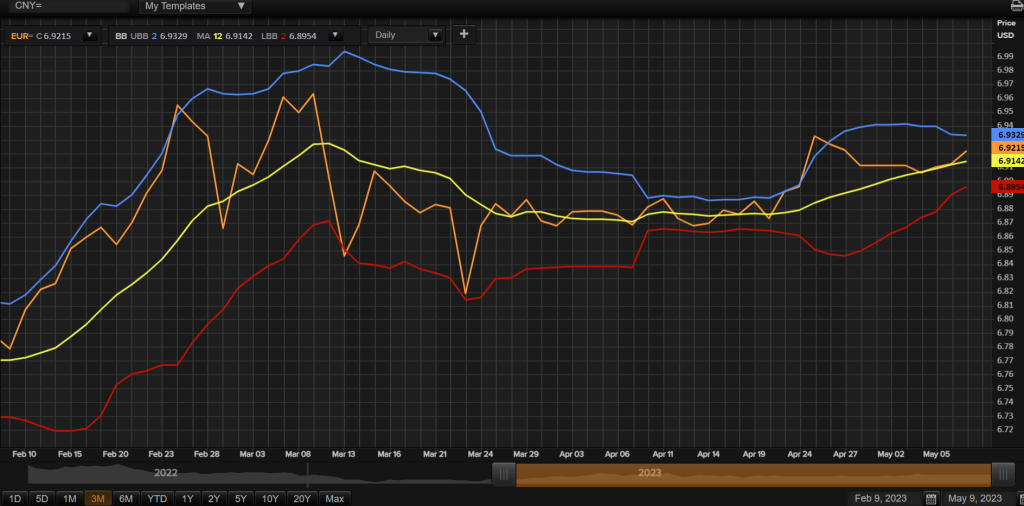China, the world’s second-largest economy, is grappling with mounting economic pressure as its exports growth continues to decelerate while imports shrink. The recent trade data released by Chinese authorities reveals a concerning trend, potentially signaling headwinds for the country’s overall economic stability. With the global trade environment remaining challenging, China faces the task of rejuvenating its exports and addressing the underlying factors contributing to the decline in imports.
Exports Weighed Down
China’s export growth has experienced a noticeable slowdown in recent months. According to the latest data, exports in April grew at a slower pace than expected, falling short of market forecasts. The 5.1% year-on-year increase in exports is considerably lower compared to the double-digit growth rates witnessed in previous years. This decline adds to the ongoing challenges faced by Chinese exporters and the broader economy.
The shrinking exports are largely attributed to multiple factors, including the persistent uncertainties surrounding global trade relations and the lingering effects of the COVID-19 pandemic. Trade tensions with major partners, such as the United States, have added further strain, leading to reduced demand for Chinese goods in crucial markets. As a result, Chinese manufacturers are feeling the impact, with many having to adjust production levels to adapt to the changing dynamics of global demand.
Declining Imports
Simultaneously, China’s imports faced a contraction in April, reflecting weakened domestic demand. The decrease of 4.1% in imports suggests a decline in consumption and investment, raising concerns about the overall health of the Chinese economy. This downward trend has been observed across various sectors, including commodities, technology, and consumer goods.
To further illustrate the changing dynamics, let’s take a closer look at the performance of the Chinese yuan against the U.S. dollar over the past six months. The graph below, sourced from Efinitiv, showcases the exchange rate fluctuations between the two currencies.

Multiple factors contribute to the shrinking imports. A combination of stricter government regulations on capital outflows and reduced investment activity has contributed to the declining imports. Additionally, China’s efforts to rebalance its economy and rely more on domestic consumption have led to a decrease in import-dependent sectors. The Chinese government’s ongoing initiatives to boost domestic production and reduce reliance on external sources have also played a role in the import decline.
The graph highlights notable fluctuations in the exchange rate between the Chinese yuan and the U.S. dollar during this period. These exchange rate movements can have a significant impact on China’s imports and exports, as they directly affect the cost competitiveness of Chinese goods in the global market.
Impact on the Chinese Economy
The sluggish exports and shrinking imports pose significant challenges for the Chinese economy. Export-oriented industries, which have been the backbone of China’s growth for decades, are now grappling with weaker demand and fierce global competition. With exports contributing significantly to the country’s GDP, any prolonged slowdown can hamper economic growth and stability.
Furthermore, declining imports can have a cascading effect on the broader Chinese economy. A decrease in imports affects industries dependent on foreign goods, potentially leading to reduced industrial activity, employment, and overall economic performance. Moreover, the decline in imports also raises concerns about China’s ability to fulfill its domestic demand and sustain its economic growth in the long run.
Government Response and Future Outlook
Recognizing the gravity of the situation, the Chinese government has taken proactive measures to address the challenges faced by exporters and revitalize the economy. Efforts are being made to diversify export markets, reduce trade barriers, and enhance competitiveness. Additionally, the government is focusing on boosting domestic consumption and promoting technological innovation to reduce dependence on imports.
However, the road to recovery will not be without obstacles. The global economic landscape remains uncertain, with trade tensions and geopolitical factors continuing to influence market dynamics. As China strives to navigate these challenges, international cooperation and a favorable global trade environment will be crucial for its economic revival.
China’s slower exports growth and shrinking imports are exerting mounting pressure on the country’s economy. The combined impact of weakened external demand and reduced domestic consumption raises concerns about China’s economic growth and stability. As China strives to navigate these challenges, international cooperation and a favorable global trade environment will be crucial for its economic revival. The coming months will be a critical period for the Chinese economy, as policymakers and businesses work tirelessly to find innovative solutions and adapt to the evolving landscape. Will China be able to reverse the downward trajectory of its exports and reignite import demand? Only time will tell. The fate of China’s economy hangs in the balance, and the world watches with bated breath to see how this economic giant weathers the storm and charts its course toward recovery.
More news from Live Trading News!
How to Buy $FBX with Credit Card on ProBit Global
Nichapat Suphap Wears Thai Luxury Brand to Met Gala
KXCO becomes an IBM Partner








